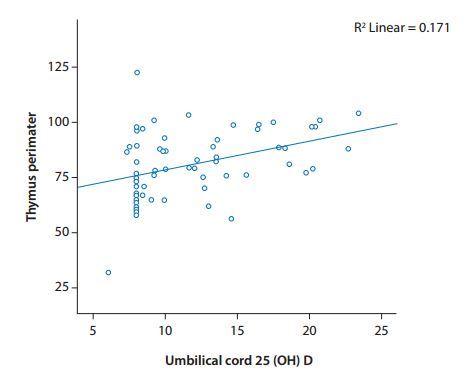Food allergies and low vitamin D – thymus may be the connection
Vitamin D deficiency in pregnancy may affect fetal thymus development.
Ginekol Pol. 2016;87(5):378-83.
Gur EB1, Gur MS, Ince O, Kasap E, Genc M, Tatar S, Bugday S, Turan GA, Guclu S.
1Department of Obstetrics and Gynecology, Faculty of Medicine, Katip Celebi University, İzmir, Turkey. esrabaharg@yahoo.com.
 WikiPedia
* "Within the thymus, T cells or T lymphocytes mature. T cells are critical to the adaptive immune system, where the body adapts specifically to foreign invaders."
* "The thymus is largest and most active during the neonatal and pre-adolescent periods."
* "Allergy results from an inappropriate and excessive immune response to common antigens. "
See also VitaminDWiki
* Allergy - Overview many of which occur before the thymus decreases in size with age
The items in Autoimmune and Infant-Child are listed here:
{category}
WikiPedia
* "Within the thymus, T cells or T lymphocytes mature. T cells are critical to the adaptive immune system, where the body adapts specifically to foreign invaders."
* "The thymus is largest and most active during the neonatal and pre-adolescent periods."
* "Allergy results from an inappropriate and excessive immune response to common antigens. "
See also VitaminDWiki
* Allergy - Overview many of which occur before the thymus decreases in size with age
The items in Autoimmune and Infant-Child are listed here:
{category}
📄 Download the PDF from VitaminDWiki

OBJECTIVES:
The aim of our study was to evaluate the association of vitamin D deficiency (VDD) during pregnancy with thymus size in full-term fetuses.
MATERIAL AND METHODS:
In this prospective study, we evaluated mid-pregnancy serum 25-hydroxyvitamin D3 (25(OH)D3) concentrations. The fetal thymus size was measured by ultrasound in the third trimester. Neonatal 25(OH)D3 levels were evaluated by umbilical cord blood sampling. Correlation of maternal and neonatal vitamin D levels and association between thymus size and both, maternal and neonatal vitamin D concentrations were investigated.
RESULTS:
Serum 25(OH) D3 concentrations were within the normal range in 48 (29.8%) mothers and 10 (13.1%) new-borns. A strong correlation between mid-pregnancy maternal and neonatal 25(OH)D3 concentration (r = 0.8, p < 0.001) was found. A significant linear correlation was observed between both, maternal and neonatal 25(OH)D3 concentrations and thymus perimeter length (r = 0.45, p = 0.04 and r = 0.43, p < 0.01, respectively). Both, maternal and fetal VDDs were associated with decreased thymus perimeter (p = 0.04, p = 0.03).
CONCLUSIONS:
Vitamin D deficiency during pregnancy may be associated with smaller fetal thymus. Our data suggest that VDD in pregnancy may lead to systemic inflammatory response in the fetus.
PMID: 27304655
